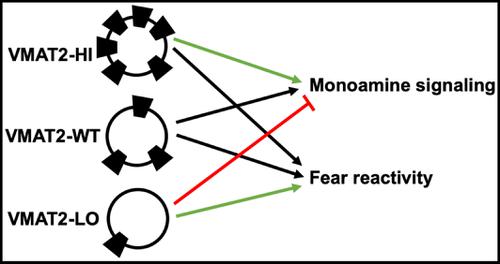当前位置:
X-MOL 学术
›
Genes Brain Behav.
›
论文详情
Our official English website, www.x-mol.net, welcomes your
feedback! (Note: you will need to create a separate account there.)
Vesicular monoamine transporter 2 mediates fear behavior in mice.
Genes, Brain and Behavior ( IF 2.4 ) Pub Date : 2020-01-03 , DOI: 10.1111/gbb.12634 Rachel C Branco 1 , James P Burkett 1 , Carlie A Black 1 , Emily Winokur 1 , William Ellsworth 1 , Rohan K Dhamsania 1 , Kelly M Lohr 1 , Jason P Schroeder 2 , David Weinshenker 2 , Tanja Jovanovic 3 , Gary W Miller 4
Genes, Brain and Behavior ( IF 2.4 ) Pub Date : 2020-01-03 , DOI: 10.1111/gbb.12634 Rachel C Branco 1 , James P Burkett 1 , Carlie A Black 1 , Emily Winokur 1 , William Ellsworth 1 , Rohan K Dhamsania 1 , Kelly M Lohr 1 , Jason P Schroeder 2 , David Weinshenker 2 , Tanja Jovanovic 3 , Gary W Miller 4
Affiliation

|
A subset of people exposed to a traumatic event develops post‐traumatic stress disorder (PTSD), which is associated with dysregulated fear behavior. Genetic variation in SLC18A2 , the gene that encodes vesicular monoamine transporter 2 (VMAT2), has been reported to affect risk for the development of PTSD in humans. Here, we use transgenic mice that express either 5% (VMAT2‐LO mice) or 200% (VMAT2‐HI mice) of wild‐type levels of VMAT2 protein. We report that VMAT2‐LO mice have reduced VMAT2 protein in the hippocampus and amygdala, impaired monoaminergic vesicular storage capacity in both the striatum and frontal cortex, decreased monoamine metabolite abundance and a greatly reduced capacity to release dopamine upon stimulation. Furthermore, VMAT2‐LO mice showed exaggerated cued and contextual fear expression, altered fear habituation, inability to discriminate threat from safety cues, altered startle response compared with wild‐type mice and an anxiogenic‐like phenotype, but displayed no deficits in social function. By contrast, VMAT2‐HI mice exhibited increased VMAT2 protein throughout the brain, higher vesicular storage capacity and greater dopamine release upon stimulation compared with wild‐type controls. Behaviorally, VMAT2‐HI mice were similar to wild‐type mice in most assays, with some evidence of a reduced anxiety‐like responses. Together, these data show that presynaptic monoamine function mediates PTSD‐like outcomes in our mouse model, and suggest a causal link between reduced VMAT2 expression and fear behavior, consistent with the correlational relationship between VMAT2 genotype and PTSD risk in humans. Targeting this system is a potential strategy for the development of pharmacotherapies for disorders like PTSD.
中文翻译:

囊泡单胺转运蛋白 2 介导小鼠的恐惧行为。
暴露于创伤事件的一部分人会出现创伤后应激障碍(PTSD),这与失调的恐惧行为有关。据报道,编码囊泡单胺转运蛋白 2 (VMAT2) 的基因SLC18A2的遗传变异会影响人类发生 PTSD 的风险。在这里,我们使用表达野生型 VMAT2 蛋白水平 5%(VMAT2-LO 小鼠)或 200%(VMAT2-HI 小鼠)的转基因小鼠。我们报告,VMAT2-LO 小鼠海马和杏仁核中的 VMAT2 蛋白减少,纹状体和额叶皮质中的单胺能囊泡存储能力受损,单胺代谢丰度降低,刺激后释放多巴胺的能力大大降低。此外,VMAT2-LO小鼠表现出夸大的暗示和情境恐惧表达、改变的恐惧习惯、无法区分威胁和安全线索、与野生型小鼠相比惊吓反应改变以及类似焦虑的表型,但没有表现出社交功能缺陷。相比之下,与野生型对照组相比,VMAT2-HI 小鼠的整个大脑中的 VMAT2 蛋白增加,囊泡储存容量更高,刺激后多巴胺释放更多。在行为上,VMAT2-HI 小鼠在大多数检测中与野生型小鼠相似,有一些证据表明焦虑样反应减少。总之,这些数据表明,在我们的小鼠模型中,突触前单胺功能介导类似 PTSD 的结果,并表明 VMAT2 表达减少和恐惧行为之间存在因果关系,这与人类 VMAT2 基因型和 PTSD 风险之间的相关关系一致。针对这一系统是开发针对创伤后应激障碍(PTSD)等疾病的药物疗法的潜在策略。
更新日期:2020-01-03
中文翻译:

囊泡单胺转运蛋白 2 介导小鼠的恐惧行为。
暴露于创伤事件的一部分人会出现创伤后应激障碍(PTSD),这与失调的恐惧行为有关。据报道,编码囊泡单胺转运蛋白 2 (VMAT2) 的基因SLC18A2的遗传变异会影响人类发生 PTSD 的风险。在这里,我们使用表达野生型 VMAT2 蛋白水平 5%(VMAT2-LO 小鼠)或 200%(VMAT2-HI 小鼠)的转基因小鼠。我们报告,VMAT2-LO 小鼠海马和杏仁核中的 VMAT2 蛋白减少,纹状体和额叶皮质中的单胺能囊泡存储能力受损,单胺代谢丰度降低,刺激后释放多巴胺的能力大大降低。此外,VMAT2-LO小鼠表现出夸大的暗示和情境恐惧表达、改变的恐惧习惯、无法区分威胁和安全线索、与野生型小鼠相比惊吓反应改变以及类似焦虑的表型,但没有表现出社交功能缺陷。相比之下,与野生型对照组相比,VMAT2-HI 小鼠的整个大脑中的 VMAT2 蛋白增加,囊泡储存容量更高,刺激后多巴胺释放更多。在行为上,VMAT2-HI 小鼠在大多数检测中与野生型小鼠相似,有一些证据表明焦虑样反应减少。总之,这些数据表明,在我们的小鼠模型中,突触前单胺功能介导类似 PTSD 的结果,并表明 VMAT2 表达减少和恐惧行为之间存在因果关系,这与人类 VMAT2 基因型和 PTSD 风险之间的相关关系一致。针对这一系统是开发针对创伤后应激障碍(PTSD)等疾病的药物疗法的潜在策略。










































 京公网安备 11010802027423号
京公网安备 11010802027423号